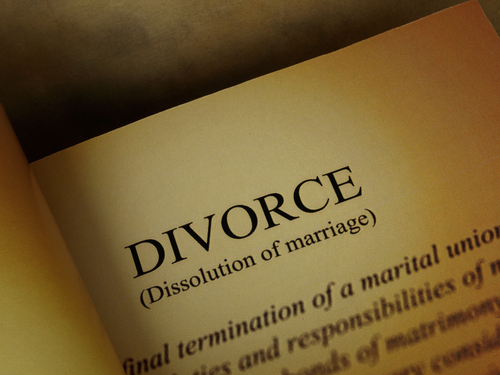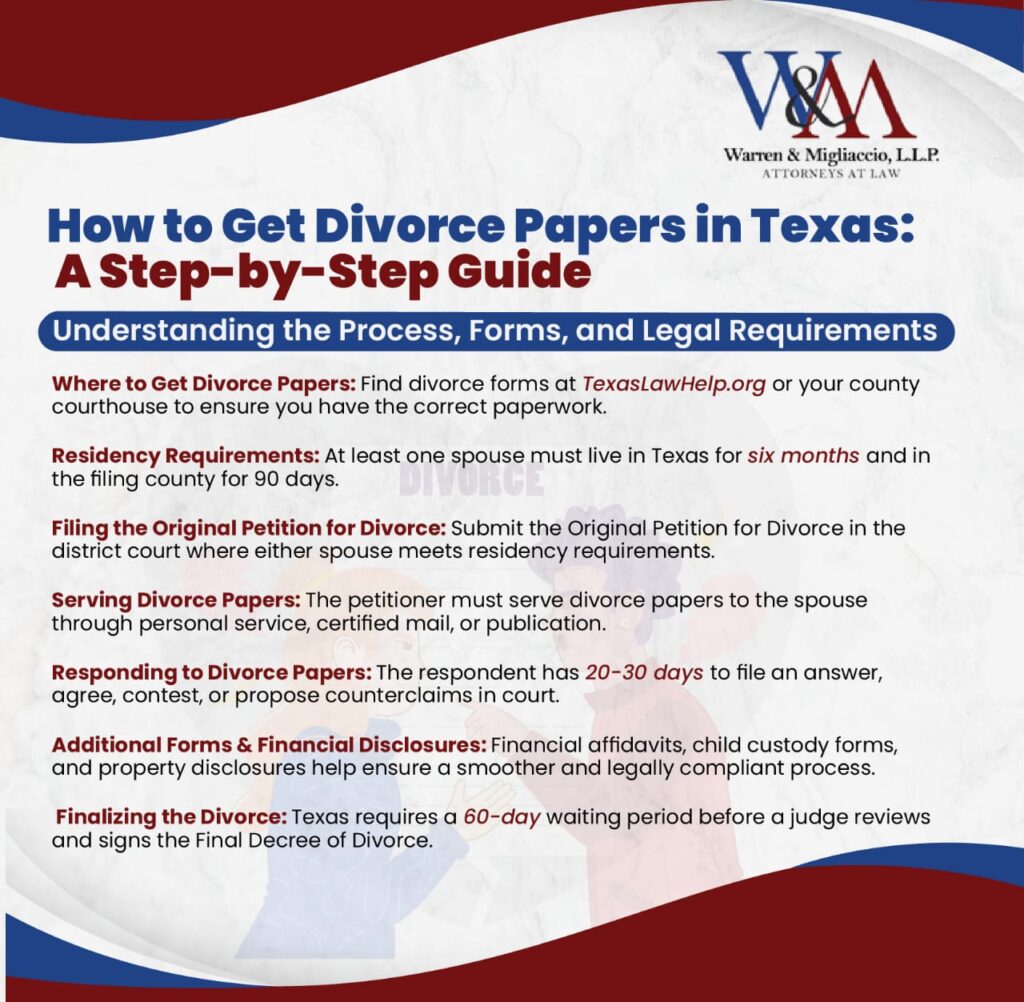To learn how to get divorce papers in Texas, visit TexasLawHelp.org or your county courthouse. These resources provide the forms you need to file for divorce.
Key Points
To get divorced in Texas, you start with the Original Petition for Divorce which requires the right forms which can be found at TexasLawHelp.org.
Texas laws govern the residency requirements for filing a divorce, which are 6 months in Texas and 90 days in the county where you’re filing to get jurisdiction.
After you file, spouses have 20-30 days to respond, address the issues promptly to avoid default judgments and make sure you exchange financial disclosures.
Texas Divorce Papers
Divorce papers are the documents that start the divorce process. They set the stage for how assets, debts and possibly child custody will be handled. Filing for divorce in Texas means ending the marriage and dividing marital property and debts under Texas laws.
Whether you have a contested or uncontested divorce, the steps to file the paperwork and start the court process are the same. Texas family law requires you to follow the steps whether you do your own divorce or hire an attorney. This includes filling out and submitting the required legal documents, making sure all completed forms are proper and filed with the right courts.

Types of Divorce Papers in Texas
In Texas, the main document to start the divorce process is the Original Petition for Divorce also known as the divorce petition. For those in an agreed divorce with no minor children or real property, the Texas Supreme Court has approved special forms to make the process easier.
TexasLawHelp.org also has forms for uncontested divorces so parties that agree on all issues can move forward. The filing spouse must decide whether to include claims about separate property or address issues like attorney fees in the first filing.
Where to Get Divorce Forms
Getting the right forms is crucial. TexasLawHelp.org has document packets for both agreed and default divorces. Texas laws provide guidance for those with children involved or special circumstances.
While Texas courts have limited official legal forms, it’s a good idea to check with the clerk’s office to make sure you have all the required paperwork before you file according to Texas law. The district clerk can tell you about any local requirements that apply in your county.
Residency Requirements for Filing Divorce in Texas
Before filing for divorce in Texas, you must meet the residency requirements. One spouse must have lived in Texas for at least six months and in the county where the divorce is filed for at least 90 days, according to Texas divorce laws.
This residency gives the court jurisdiction over your case. Meeting these requirements is crucial before the spouse seeking maintenance or the paying spouse can proceed with divorce actions.
Texas Residency Rules
Both spouses must have lived in Texas for 6 months straight before filing for divorce. You also have to have lived in the county where you’re filing for at least 90 days.
Even if one spouse lives outside of Texas, you can file for divorce if the other spouse has been a resident for 6 months. This ensures the state of Texas has authority over the proceedings especially when there are children involved or complex property issues.
How to Prove Residency
Proving residency is easy with the right documents. You can use utility bills, lease agreements and employment records as evidence you live in Texas. With proper documentation the court will accept your residency and the divorce can move forward.
For most divorces a simple affidavit will be enough but in contested cases you may need more evidence to prove the filing spouse has met all residency requirements.
Filling Out Your Divorce Papers
Preparation is key when it comes to divorce forms. First identify the right forms for your situation, whether it’s an uncontested or contested divorce. You can fill out forms online or through an online divorce service.
Working with your spouse and having available help can make the process much smoother. Always double check that all required documents are completed correctly before filing with the right court, as Texas laws require all completed documents to be filed correctly. In cases of family violence or a disabled child you may need special forms to address those specific situations.

My Experience With Simplified Divorce Processes
I recently worked with a client who was worried about the complexity of getting divorce papers. She came to my office feeling overwhelmed thinking the process would be time consuming and confusing.
We sat down together and I explained since she and her spouse had already agreed on all terms – including how to divide their assets and debts – they qualified for an uncontested divorce.
The hardest part was making sure all financial information was disclosed. We listed every account and property item, making sure nothing was missed. I emphasized the importance of transparency even in an amicable situation. When we hit the 20 day waiting period she was surprised to learn even with complete agreement Texas law required a 60 day waiting period before finalizing. I explained this cooling off period is to give couples time to think.
In the end what she thought would be a months long process was completed with minimal court appearances and easy paperwork. This was proof to me that with the right guidance the process of getting divorce papers is not as scary as many people think.
Submitting the Petition for Divorce
The Original Petition for Divorce, also known as the divorce petition, is the foundation of your divorce paperwork. While a divorce lawyer can help draft these documents, a fill-in-the-blank form is also available if you want to do it yourself.
For uncontested divorces, forms from TexasLawHelp.org will make the process easier. The petition should state if there are minor children, mental hospital confinement of a spouse, or if you’re claiming several fault-based grounds for the divorce.
Additional Required Forms
You may need additional documents such as financial disclosures and custody agreements depending on your case. Make sure these are included in your filing package for a smooth divorce process.
A waiver form signed by the responding spouse can speed up an uncontested divorce, while cases involving the attorney general (usually for child support) require additional notice procedures. If domestic violence is involved, you may also need to file protective orders with divorce papers.
Filing Your Divorce Papers
Once your forms are ready, the next step is to file them with the court. You must file divorce papers in the district court of the county where either spouse has lived for the last 90 days.
Texas also offers e-filing, so you can submit documents electronically. Texas laws require a 60-day waiting period before the divorce can be final, unless there’s family violence.
Choosing the Right Court
Choosing the right district court is important because it determines who has jurisdiction over your divorce case. Filing first gives you the advantage of choosing the county, which can impact the whole process.
Meeting the residency requirement ensures you file in the right district court, so the divorce will be smoother. The court will need to have jurisdiction to divide assets and make decisions about personal injuries or claims for separate property.
Filing Fees and Waivers
Filing fees for divorce in Texas are $200 to $300 and are paid by the filing party. If you can’t afford the fee, you can submit a Statement of Inability to Afford Court Costs form or an Affidavit of Inability to Pay Court Costs to request a waiver.
The clerk’s office can tell you what the fees are in your county and how to request a waiver if you can’t afford the filing fee due to financial hardship.
Serving Divorce Papers on Your Spouse
Serving divorce papers is an important step in the divorce process as it notifies your spouse of the legal action. The petitioner must follow specific legal procedures to ensure the respondent is properly notified. If the respondent can’t be found, you may need to use alternative methods like service by publication in a local newspaper.

Service of process is a formal requirement that ensures the other spouse has legal notice of the proceedings and a chance to respond.
Methods of Service
You can serve divorce papers through:
Personal service by an authorized process server
Registered or certified mail requiring a signed receipt with return receipt requested
Substituted service via email or social media (if traditional methods fail)
Service by publication (when the respondent can’t be found after diligent efforts)
A process server or county constable can provide official service that meets legal requirements.
Proof of Service
Proof of service is important to ensure compliance with legal requirements. This can be a signed return receipt from certified mail or an affidavit from the server. Proper documentation of service methods is crucial for the court to acknowledge the respondent was notified.
Without proper service, the court can’t proceed with the divorce case as it lacks jurisdiction over the non-filing spouse. Making sure service is done is one of the most important procedural steps in the divorce process.
Responding to Divorce Papers
After receiving divorce papers, the respondent must act to protect their rights. Voluntarily accepting the papers and signing an answer or waiver of service form can simplify the process to serve divorce papers.
Proper documentation of service ensures the court acknowledges the respondent’s notification. In cases where spouses agree, the responding spouse can sign a waiver form that speeds up the process by waiving formal service requirements.
Filing an Answer
After receiving divorce papers, a spouse usually has 20 to 30 days to respond. This timeframe is important to move forward with the divorce process. This response can agree with the terms, propose counterterms or contest specific issues.
Not responding may result in a default judgment, meaning the court could rule in favor of the spouse filing for divorce. At this stage, both parties should make sure they have proper legal advice to protect their interests, especially when there are complex issues like proving fault or claims for separate property.
Counterclaims and Contests
A contested divorce occurs when spouses can’t agree on one or more issues. These disagreements can make the process more complicated compared to an uncontested divorce where both parties agree on everything. Contested divorces can be tough for everyone involved.
Issues that often lead to contestation are:
How to split assets
Spousal maintenance
Minor children arrangements
When fault is claimed as grounds for divorce, the divorce process becomes more complicated as you need to prove fault with evidence and testimony.
Next Steps After Filing
After you file and respond to the divorce papers, the next steps involve temporary orders and financial disclosures. Responding quickly ensures you have a voice in the process and prevent a default against you.
Temporary court orders can address urgent issues like child custody and child support during the divorce. Getting a court date scheduled quickly will help get these important interim issues resolved.
Temporary Orders
You can request temporary orders to handle urgent issues like financial support and property preservation during the divorce. These can also prohibit actions like hiding or damaging property.
If domestic violence or family violence is involved, emergency protective orders may be issued to ensure safety during the divorce process. These temporary orders remain in effect until modified by the court or until the final decree of divorce is issued.
Financial Disclosures
Both spouses have to exchange initial disclosures about property and finances within 30 days of an Answer being filed. These disclosures include:
Sworn financial affidavits
Lists of income sources
Records of financial obligations
Not providing full disclosures can impact the settlement and result in penalties. Full disclosure is especially important when there are complex assets to divide or when one spouse has more financial knowledge than the other.
Statistical Analysis of Texas Divorce Proceedings

Texas divorce statistics reveal important trends that can help individuals understand what to expect when filing for divorce in the state.
According to the Texas Department of State Health Services, approximately 75,000 divorces are granted annually in Texas, with a divorce rate of 2.2 per 1,000 population. [https://www.dshs.texas.gov/vital-statistics]
The average divorce in Texas takes 12 months to complete, though uncontested divorces can be finalized in as little as 61 days after the mandatory waiting period. [https://www.txcourts.gov/statistics/annual-statistical-reports/]
Financial data shows that the average cost of a contested divorce in Texas ranges from $15,000 to $30,000, while uncontested divorces typically cost between $1,000 and $3,000. [https://www.texasbar.com/AM/Template.cfm?Section=articles]
Real-World Case Study: Expedited Divorce Process in Cases of Family Violence
In a 2022 Harris County case (In re Marriage of Johnson, No. 2022-35621), the court demonstrated how Texas family law provides exceptions to the standard waiting period in cases involving family violence. The petitioner provided evidence of a recent protective order, which allowed the court to waive the typical 60-day waiting period.
The court granted the divorce within 30 days of filing, demonstrating the legal system’s recognition that family violence creates circumstances where expeditious resolution is in the best interest of the affected spouse. The case included specific provisions for the division of marital property that accounted for economic effects of the documented abuse.
This case highlights the importance of proper documentation and legal representation when family violence is present in divorce proceedings. The petitioner’s attorney successfully demonstrated that the expedited process was necessary for the client’s safety and financial stability. [Source: Harris County District Clerk Records, https://www.hcdistrictclerk.com/]
Getting Finalized
Getting finalized involves going to court and the judge reviewing the case. 61 days is the minimum to get finalized in Texas, but it usually takes 6-12 months.
Both parties and their attorneys must attend the final hearing where the judge will review everything and issue a Final Decree of Divorce. This decree will outline how to divide assets, spousal maintenance and child arrangements if applicable.
Court Hearing Preparation
You must be prepared for court for a good outcome. Getting ready for court means:
Gathering all your documents
Collecting evidence to support your case
Organizing everything ahead of time so it goes smoothly
If you are proving fault you will need to have evidence ready. Both parties need to be prepared to answer questions from the judge about the proposed property division or child custody arrangements.
Getting the Decree
The Final Decree of Divorce is a legal document finalizing the divorce and outlining the court’s decisions on asset division, child custody and support obligations. It is the legal responsibilities of each spouse post-divorce and enforces the court’s orders.
Once the judge signs the decree the marriage is dissolved and both parties must follow the terms in the document. In cases where one spouse doesn’t follow the terms of the decree the other spouse can go back to court to enforce.

Frequently Asked Questions
Eligibility
What are the residency requirements for filing for divorce in Texas?
To file for divorce in Texas, one spouse must have lived in the state for at least six months. They must also reside in the filing county for at least 90 days. These rules ensure the court has jurisdiction over the case.
What are the grounds for divorce in Texas?
Texas allows both “no-fault” and fault-based divorces. No-fault divorce is based on insupportability, meaning the marriage is no longer working. Fault-based reasons include adultery, cruelty, or abandonment. While most choose a no-fault divorce, proving fault can impact property division and spousal support. See our simple guide about divorce grounds in Texas.
The Divorce Process
How long does it take to finalize a divorce in Texas?
At a minimum, a Texas divorce takes 61 days after filing. But most divorces take 6 to 12 months, especially if there are disputes over property or child custody.
What is the difference between a contested and an uncontested divorce?
An uncontested divorce happens when both spouses agree on all terms, such as property division and custody. A contested divorce occurs when they disagree on one or more issues. Contested cases take longer and may require court intervention.
What happens if my spouse cannot be located to serve divorce papers?
If your spouse is missing, you can request “service by publication.” This means publishing a notice in a local newspaper. This legal step allows your divorce to proceed even if your spouse is unreachable.
Can I get a divorce without going to court?
Usually, at least one court appearance is required, called a “prove-up” hearing. Some counties allow virtual hearings, but you typically cannot finalize a divorce with only paperwork.
What is the easiest way to get a divorce in Texas?
An uncontested divorce is the simplest. If both spouses agree on all terms, they can file the forms and finalize the divorce without delays.
How do I fill out divorce papers?
Texas offers fill-in-the-blank forms, often found on TexasLawHelp.org. Complete all sections, attach required documents, and ensure you use the correct forms for your case.
How can I get my divorce papers in Texas?
You can find divorce forms online at TexasLawHelp.org or at your local courthouse. These resources provide official packets and instructions for different types of divorces.
Online Divorce
Can I file for divorce online in Texas?
Yes. Texas allows e-filing for divorce, so you can submit forms electronically instead of going to the courthouse. This can speed up the process.
Can I get an online divorce in Texas if I have children?
Yes, but if children are involved, extra paperwork is required for custody and support. You may also need a court appearance, either in person or virtual, to finalize the case.
Financial and Custody Matters
How does child support work in Texas divorces?
Texas follows state guidelines based on the paying parent’s income and the number of children. Courts can adjust payments if special circumstances apply, but the goal is to meet the child’s needs.
What is spousal support?
Spousal support, or alimony, is money one spouse pays the other after divorce. Texas courts consider the length of the marriage, each spouse’s income, and whether the receiving spouse can meet basic needs.
Is Texas a 50/50 divorce state?
Texas follows community property laws. This means most assets acquired during the marriage belong to both spouses. Courts start with a 50/50 split but can adjust based on income differences, misconduct, or other factors.
Conclusion on How to Get Divorce Papers in Texas
Getting a divorce in Texas involves understanding the necessary steps, from obtaining the right forms to meeting residency requirements and following proper filing procedures. Whether handling the process on your own or with legal guidance, having the right information is essential.
The process begins with filing the Original Petition for Divorce and serving your spouse. After addressing temporary orders and exchanging financial details, you’ll need to wait out the required period before finalizing your divorce in court and receiving your Final Decree of Divorce.
Understanding how to obtain divorce papers in Texas is the first step in navigating this major life transition. If you need legal guidance, our experienced Texas divorce attorneys can help you understand your options, protect your rights, and guide you through every stage of the process. Call us at (888) 584-9614 or contact us online to discuss your situation.

